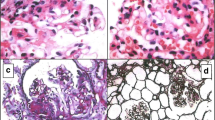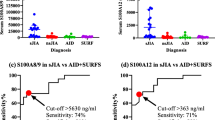Abstract
Background
We compared serum levels of S100A12, a proinflammatory protein predominantly secreted by neutrophils, in children with newly diagnosed childhood-onset systemic lupus erythematosus (cSLE), systemic juvenile arthritis (sJIA), and systemic undefined recurrent fevers (SURFS) to examine its role as a diagnostic and discriminative marker of inflammation and to indirectly point out the importance of neutrophils and innate immunity in the pathogenesis of these diseases.
Materials and methods
In a cross-sectional study, the serum levels of S100A12 protein of 68 children (19 with cSLE, 18 with sJIA, 7 with SURFS, and 24 controls) were determined by enzyme-linked immunosorbent assay and compared between groups and with clinical and laboratory findings.
Results
The median serum S100A12 levels were 469 ng/mL in the cSLE group, 6103 ng/mL in the sJIA group, 480 ng/mL in the SURFS group, and 44 ng/mL in the control group. Children with cSLE, sJIA, and SURFS had significantly higher serum S100A12 levels compared to the control group (p < 0.0001). sJIA patients had the highest levels of S100A12 in comparison to other patients (p < 0.0001), while there was no significant difference between children with cSLE and SURFS.
Conclusion
Elevated serum SA100A12 levels in children with cSLE, sJIA, and SURFS may indicate intense neutrophil activation, which may play an important role in innate immunity in chronic inflammation in these diseases. Serum S100A12 levels could be used as a diagnostic marker of inflammation and be suitable for distinguishing sJIA and other disorders.
Zusammenfassung
Hintergrund
Die Serumspiegel von S100A12, einem hauptsächlich von Neutrophilen sezernierten proinflammatorischen Protein, bei Kindern mit neu diagnostiziertem systemischem Lupus erythematodes (cSLE), systemischer juveniler idiopathischer Arthritis (sJIA) und systemischen undefinierten wiederkehrenden Fieberschüben (SURFS) wurden verglichen. Das Ziel war, die Rolle von S100A12 als diagnostischem und diskriminierendem Entzündungsmarker zu untersuchen und indirekt sowohl auf die Bedeutung von Neutrophilen als auch der angeborenen Immunität bei der Pathogenese dieser Krankheiten hinzuweisen.
Material und Methoden
In einer Querschnittsstudie wurden die Serumspiegel des S100A12-Proteins von 68 Kindern (19 mit cSLE, 18 mit sJIA, 7 mit SURFS und 24 Kontrollen) durch den ELISA-Test („enzyme-linked immunosorbent assay“) bestimmt und zwischen den Gruppen sowie mit klinischen und Laborbefunden verglichen.
Ergebnisse
Die medianen Serumspiegel von S100A12 betrugen 469 ng/ml in der cSLE-Gruppe, 6103 ng/ml in der sJIA-Gruppe, 480 ng/ml in der SURFS-Gruppe und 44 ng/ml in der Kontrollgruppe. Kinder mit cSLE, sJIA und SURFS wiesen jeweils signifikant höhere S100A12-Serumspiegel als die Kontrollgruppe auf (p < 0,0001). sJIA-Patienten hatten die höchsten S100A12-Spiegel im Vergleich zu anderen Patienten (p < 0,0001), während es keinen signifikanten Unterschied zwischen Kindern mit cSLE und SURFS gab.
Schlussfolgerung
Erhöhte S100A12-Serumspiegel bei Kindern mit cSLE, sJIA und SURFS können auf eine intensive Neutrophilenaktivierung hinweisen, die eine wichtige Rolle in der angeborenen Immunität bei chronischen Entzündungen im Rahmen dieser Krankheiten spielen könnte. Die S100A12-Serumspiegel könnten als diagnostischer Entzündungsmarker verwendet werden und zur Unterscheidung von sJIA und anderen Erkrankungen geeignet sein.

Similar content being viewed by others
References
Gonzalez LL, Garrie K, Turner MD (2020) Role of S100 proteins in health and disease. Biochim Biophys Acta Mol Cell Res 1867:118677
Pietzsch J, Hoppmann S (2009) Human S100A12: a novel key player in inflammation? J Amino Acids 36:381–389
Li SC, Tsai KW, Huang LH et al (2020) Serum proteins may facilitate the identification of Kawasaki disease and promote in vitro neutrophil infiltration. Sci Rep 10:15645
Foell D, Wittkowski H, Hammerschmidt I et al (2004) Monitoring neutrophil activation in juvenile rheumatoid arthritis by S100A12 serum concentrations. Arthritis Rheum 50:1286–1295
Aljaberi N, Tronconi E, Schulert G et al (2020) The use of S100 proteins testing in juvenile idiopathic arthritis and autoinflammatory diseases in a pediatric clinical setting: a retrospective analysis. Pediatr Rheumatol Online J 18:7
Tydén H, Lood C, Gullstrand B et al (2017) Pro-inflammatory S100 proteins are associated with glomerulonephritis and anti-dsDNA antibodies in systemic lupus erythematosus. Lupus 26:139–149
Turnier JL, Fall N, Thornton S et al (2017) Urine S100 proteins as potential biomarkers of lupus nephritis activity. Arthritis Res Ther 19:242
Šumová B, Cerezo LA, Szczuková L et al (2019) Circulating S100 proteins effectively discriminate SLE patients from healthy controls: a cross-sectional study. Rheumatol Int 39:469–478
Huttenlocher A, Smith JA (2015) Neutrophils in pediatric autoimmune disease. Curr Opin Rheumatol 27:500–504
Hochberg MC (1997) Updating the American college of rheumatology revised criteria for the classification of systemic lupus erythematosus. Arthritis Rheum 40:1725
Petty RE, Southwood TR, Manners P et al (2004) International league of associations for rheumatology classification of juvenile idiopathic arthritis: second revision, Edmonton, 2001. J Rheumatol 31:390–392
Gladman DD, Ibañez D, Urowitz MB (2002) Systemic lupus erythematosus disease activity index 2000. J Rheumatol 29:288–291
Tibaldi J, Pistorio A, Aldera E et al (2020) Development and initial validation of a composite disease activity score for systemic juvenile idiopathic arthritis. Rheumatology (Oxford) 59:3505–3514
Bobek D, Grcevic D, Kovacic N et al (2014) The presence of high mobility group box‑1 and soluble receptor for advanced glycation end-products in juvenile idiopathic arthritis and juvenile systemic lupus erythematosus. Pediatr Rheumatol Online J 12:50
Prakken B, Albani S, Martini A (2011) Juvenile idiopathic arthritis. Lancet 377:2138–2149
Lukic A, Lukic IK, Malcic I et al (2013) Childhood-onset systemic lupus erythematosus in Croatia: demographic, clinical and laboratory features, and factors influencing time to diagnosis. Clin Exp Rheumatol 31:803–812
Fagerholm SC, MacPherson M, James MJ et al (2013) The CD11β integrin (ITGAM) and systemic lupus erythematosus. Lupus 22:657–663
Villanueva E, Yalavarthi S, Berthier CC et al (2011) Netting neutrophils induce endothelial damage, infiltrate tissues, and expose immunostimulatory molecules in systemic lupus erythematosus. J Immunol 187:538–552
Midgley A, Beresford MW (2011) Cellular localization of nuclear antigen during neutrophil apoptosis: mechanism for autoantigen exposure? Lupus 20:641–646
Whittall-García LP, Torres-Ruiz J, Zentella-Dehesa A et al (2019) Neutrophil extracellular traps are a source of extracellular HMGB1 in lupus nephritis: associations with clinical and histopathological features. Lupus 28:1549–1557
Knight JS, Kaplan MJ (2012) Lupus neutrophils: ‘NET’ gain in understanding lupus pathogenesis. Curr Opin Rheumatol 24:441–450
Narayanan K, Marwaha V, Shanmuganandan K et al (2010) Correlation between systemic lupus erythematosus disease activity index, C3, C4 and anti-dsDNA antibodies. Med J Armed Forces India 66:102–107
ter Borg EJ, Horst G, Hummel EJ et al (1990) Measurement of increases in anti-double-stranded DNA antibody levels as a predictor of disease exacerbation in systemic lupus erythematosus. A long-term, prospective study. Arthritis Rheum 33:634–643
Linnik MD, Hu JZ, Heilbrunn KR et al (2005) Relationship between anti-double-stranded DNA antibodies and exacerbation of renal disease in patients with systemic lupus erythematosus. Arthritis Rheum 52:1129–1137
Lin YT, Wang CT, Gershwin ME et al (2011) The pathogenesis of oligoarticular/polyarticular vs systemic juvenile idiopathic arthritis. Autoimmun Rev 10:482–489
Funding
No specific grant from any public or commercial agency was received for this study.
Author information
Authors and Affiliations
Corresponding author
Ethics declarations
Conflict of interest
D. Bobek, M. Sestan, L. Mijacika, N. Kovacic, I.K. Lukic, D. Grcevic, and M. Jelusic declare that they have no competing interests.
All procedures performed in studies involving human participants or on human tissue were in accordance with the ethical standards of the institutional and/or national research committee (Ethics Committee of the University of Zagreb School of Medicine, Zagreb, Croatia) and with the 1975 Helsinki declaration and its later amendments or comparable ethical standards. Informed consent was obtained from all individual participants included in the study.
Additional information
Redaktion
Ulf Müller-Ladner, Bad Nauheim
Uwe Lange, Bad Nauheim

Scan QR code & read article online
Rights and permissions
About this article
Cite this article
Bobek, D., Sestan, M., Mijacika, L. et al. Serum S100A12 levels in children with childhood-onset systemic lupus erythematosus, systemic juvenile arthritis, and systemic undefined recurrent fevers. Z Rheumatol 82 (Suppl 1), 74–79 (2023). https://doi.org/10.1007/s00393-021-01142-9
Accepted:
Published:
Issue Date:
DOI: https://doi.org/10.1007/s00393-021-01142-9




